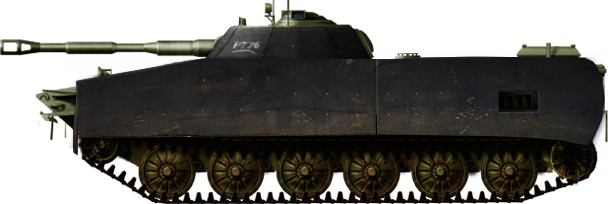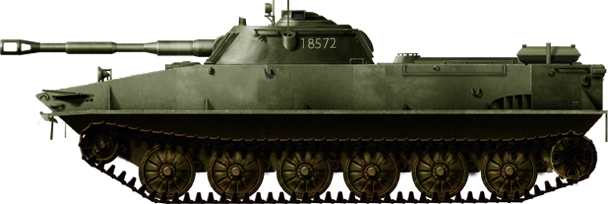 Socialist Federal Republic of Yugoslavia (1968)
Socialist Federal Republic of Yugoslavia (1968)
Amphibious Light Tank – 63 Operated
During the 1960s, the Jugoslovenska Narodna Armija, JNA (Yugoslav People Army, YPA) wanted to replace their aging Second World War reconnaissance armored cars. Given the good military cooperation between the Soviet Union and Yugoslavia, it was logical for the JNA military to ask the Soviets for such equipment. By the late 1960s, an agreement was sought for purchasing 63 PT-76B amphibious light tanks. These would be used to reinforce the reconnaissance elements of many armored units. During the Yugoslav wars of the 1990s, these would see action mostly as fire support vehicles.

The Need for a Reconnaissance Vehicle
In the years after the Second World War, the main reconnaissance vehicles of the JNA were the American-built M3A1 Scout Cars and M8 Armored Cars. These were clearly aging and outdated designs and not suited for more modern combat operations, having insufficient firepower and weak armor protection. On some occasions, Sherman or T-34-85 tanks were used to supplement the firepower of reconnaissance units. The JNA needed a more modern vehicle that had sufficient firepower and good speed to reinforce the reconnaissance elements of the armored formations.

In the 1960s, JNA Army officials began negotiating with the Soviet Union to resolve this issue. As a provisional solution, small numbers of BRDM-1 reconnaissance armored cars were acquired. However, this only temporarily solved the critical lack the suitable vehicles. In 1965, JNA Army officials decided to try to procure the PT-76 amphibious light tank. While the necessary funds were allocated for this project, the final decision was postponed for the next year.
In early 1966, a delegation led by the commander of the Yugoslav Armored Formations, General Dušan Ćorković, arrived in the Soviet Union. In March 1966, another delegation arrived in the Soviet Union to finalize an agreement for the purchase of military equipment. Interestingly, during the initial negotiations, the Yugoslav delegation showed interest in buying the new BMP-1 infantry fighting vehicles, but nothing came from this. Eventually, the deal was struck for the purchase of 600 T-34-85 and 67 PT-76B tanks, although the number of PT-76Bs was eventually reduced to 63. As these vehicles began to arrive in late 1967, they would be first transported to the military base at Pančevo, near the Yugoslav capital of Belgrade. Officially the PT-76Bs were accepted into service on 25th April 1968.

PT-76B
Work on a new Soviet amphibious light tank began shortly after the end of the Second World War. It was introduced to service in the early 1950s. The PT-76 had good amphibious capabilities. On the other hand, it was a relatively large target and had poor armor protection. Despite this, some 12,000 would be produced and would see widespread use in the Soviet Army (and later Russian army, up to 2006), as well as service aboard. During its service life, a number of modifications would be introduced in order to improve its overall performance and extend its operational service life. One of these included the PT-76B (original name PT-76 Model 1957), which incorporated changes such as an improved muzzle brake. This version would be exported to Yugoslav Army.

Organization and distribution to first units
Once the PT-76Bs were available, they would be used to reinforce the reconnaissance companies of armored units. The basic unit was a Platoon that consisted of three PT-76Bs and was supported by a Platoon of BRDM-2 armored cars (also with three vehicles). These were mainly allocated to Armored Regiments in addition to the Armored and Mechanized Brigades. During its service life, the PT-76B was almost never issued in units greater than a Platoon. The only exception to this rule was the reconnaissance Battalion of the 7th Armored Division, which had in its inventory 7 PT-76B tanks. A few tanks were allocated to various training centers and schools.

Service Life
The PT-76B in JNA service kept the original Soviet dark green camouflage. In addition, it received five-digit numbers painted in white. These were usually painted on the turret sides.
In order to train new crews, the first vehicles were allocated to various training schools. Initial training programs were carried out with the help of Soviet instructors from 15th May to 15th August 1968 at the main training center in Banjaluka. After some experience was gained with operating the PT-76B tanks, it was possible for further training to be conducted with JNA instructors. The first local training was carried out on the Sava river and later at a specially designed military range at Manjača.

The PT-76B was frequently used during military exercises during the 1970s and 1980s. It would be also used during one of the largest military maneuvers ever undertaken in Yugoslavia, named ‘Sloboda 71’ (English: ‘Freedom’). These lasted from 2nd to 9th October 1971, and some 40,000 regular and territorial defense soldiers were present, together with large quantities of newly acquired equipment. This maneuver also had a political background. After the Prague Uprising in 1968, political tension in Europe was high. At that time, there was even some political turmoil in Yugoslavia, especially in Croatia. This potential quelling of political instability has often been cited as one of the main reasons why the Sloboda 71 maneuvers were actually carried out. The PT-76Bs were also present on a number of military parades held in the Yugoslav capital of Belgrade.
During the early 1990s, there was a huge military reorganization of the JNA known as Jedinstvo-2 (English: ‘Unity’). It was planned that the JNA would operate some 3,078 tanks during the following years, including 48 PT-76Bs.


Yugoslav Wars
During 1991, the tensions between the Yugoslav Federal Republics worsened to the point that open conflict erupted. The JNA was initially involved in preventing any larger military uprisings, which it ultimately failed to prevent. During 1992, the JNA initiated a general evacuation of its personnel and equipment to Serbia. Many of its vehicles had to be left behind, and they were often captured and reused by the various military and paramilitary organizations which were present in Croatia, Bosnia, and Herzegovina. The PT-76B, while a rare vehicle during this conflict due to the small number operated by the JNA, would be operated by all warring parties in Yugoslavia to a limited extent.
One of the first engagements of the PT-76B during the Yugoslav wars was as a part of the 1st Armored Brigade (which had three vehicles), which was stationed in Vrhnika, in Slovenia. A JNA armored column was advancing in the direction of Vrhnika-Ljubljana-Kranj at the end of June 1991. This group with three PT-76B was tasked with taking the Rateče border crossing and the Karavanke crossing. Shortly later, a brief engagement with the Slovenian territorial defence forces occurred at the Karavanke crossing. The PT-76B was used in this engagement. While one of them was hit (sources do not specify the weapon used), no damage was noted on it. After a few days, the JNA elements that participated in these operations surrendered to Slovenian forces and the three PT-76B were captured.

The Yugoslav collapse was chaotic in its nature, and this also reflected in the overall operation and use of equipment by the JNA. Despite being intended to fulfill the role of reconnaissance, during the Yugoslav wars, the PT-76Bs were used in certain combat situations for which it was never indeed to. For example, the PT-76Bs were often used to spearhead attacks either in urban centers or against fortified positions. Being lightly armored, the choice of these vehicles to lead an assault verged on suicidal. On one such occasion, a PT-76B was destroyed during an attack on the village of Jankovci.

The use of large amounts of anti-tank weapons, close proximity to the frontline, and, in many cases, hilly terrain prevented the PT-76B from performing its original task as a reconnaissance vehicle. For these reasons, the PT-76B was mostly used as a fire support vehicle. It is also unknown if the PT-76B was ever used in any offensive amphibious assault during the war.
Anti-tank weapons, which were either captured from the JNA or even received from outside of Yugoslavia, caused huge problems to any armored vehicles. To protect themselves, crews of many tanks, including PT-76Bs, often added improvised additional armor. This basically consisted of whatever was at hand (storage boxes, spare tires, rubber, etc).

The majority of PT-76Bs would be used by the JNA and later the new Federal Republic of Yugoslavia Army. The Slovenian forces managed to capture some 3 vehicles. Croatian armored forces captured at least 10 such vehicles during 1991, which then saw action during the war. A few, possibly up to four, PT-76Bs were operated by the Army of the Srpska Krajina. Lastly, some 9 to 11 (depending on the source) vehicles were used by the Army of the Republika Srpska.

A video of the PT-76Bs of the Army of the Republika Srpska.
https://www.youtube.com/watch?v=dX-KHfOoTZw
Final Fate
Following the conclusion of the Yugoslav wars, in 1996, an agreement for the reduction of arms and weapons was signed by all sides. With this agreement, most of the older equipment was declared surplus and, in many cases, scrapped. The new Yugoslav Army still had over 30 PT-76B light tanks in its inventory. The majority of these, some 33, would be scrapped in 1997 (or 1996 depending on the source). The few vehicles in the Army of the Republika Srpska were also scrapped later in 2000. Croatian and Slovenian vehicles were also mostly removed from service by the war’s end.

A New Chance
The Army Federal Republic of Yugoslavia, while scrapping the majority of the PT-76Bs, preserved some turrets. Based on the experience from the Yugoslav wars, the Army wanted to develop and build a number of small fire support boats. These were to be armed with one PT-76B turret each. This plan never materialized, mostly due to a lack of funds and political will. In 1999 and 2000, there were new proposals to revive the project, but ultimately, nothing came from this, and the fate of these turrets is not clear. They were likely scrapped.

Surviving Vehicles
At least two PT-76s are now preserved in Serbia. Both are placed in Army storage, with one in Žarkovo and the second in Kačarevo. Another one is located in Bosnia and Herzegovina, in the Kozara museum. One more is located in the Slovenian Museum in Pivka and a few more are located in Croatia.


Conclusion
The PT-76B was operated by the JNA in quite small numbers compared with other tanks imported from the Soviet Union. By the time of the Yugoslav 1990s wars, it was a rare vehicle and would see little use. It would mostly be employed as mobile artillery and never saw combat in its original intended role.


PT-76B specifications |
|
| Dimensions (L-w-h) | 7.62 x 3.14 x 2.55 m |
| Total weight, battle-ready | 14.4 tonnes |
| Crew | 3 (Commander, Loader, and Driver) |
| Propulsion | V-6, 6 cylinder in-line, 4-stroke, water-cooled diesel, outputting 240 hp@ 1800 rpm |
| Speed | 44 km/h, 10-12 km/h (cross country), 10-11 (on water) |
| Range | 400 km, 100 km (on water) |
| Primary Armament | Armament: 76.2 mm D-56TM |
| Elevation Armament | 7.62 mm SGMT |
| Armor | 6-15 mm |
| Number operated | 63 |
Sources
- A. Radić (2014) Arsenal 83
- B. B. Dumitrijević (2010), Modernizacija i intervencija, Jugoslovenske oklopne jedinice 1945-2006, Institut za savremenu istoriju
- B. Gregurić and V. Jereb (2001) Croatian Army Vehicles 1991-1995, Sveučilišna Knjižnica Rijeka
- P. Trewhitt (1999) Armored Fighting Vehicles, Grange Book.
- http://www.srpskioklop.paluba.info/
- https://www.parkvojaskezgodovine.si/plavajoci-tank-pt-76/
